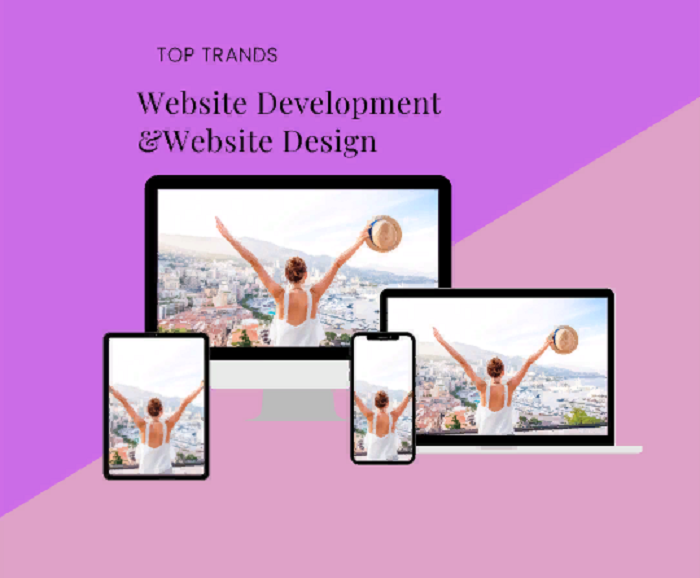✨🚀 Welcome to the thrilling journey of website design and development. As we look back, it’s evident that our virtual landscape has transformed dramatically.
From the first rudimentary websites in the 90s, which were mere digital pamphlets, we’ve journeyed through an era of flash-based sites to our current world of responsive, AI-driven, and user-centric web experiences.
Our digital landscape has evolved at a blistering pace, mimicking the speed of light. With each passing year, technology leaps and bounds, altering how we interact with the web. Consequently, the field of website design and development isn’t static – it’s a living, breathing entity, continuously morphing and growing.
This perpetual change makes it crucial to stay updated with the latest trends. An elegant design or cutting-edge technology today might become obsolete tomorrow. As web developers and designers, we must remain vigilant, ready to adapt, and eager to innovate. Failing to do so may leave us in the digital dust while our competitors speed ahead.
In this article, we’ll explore the top trends in website development and design for 2023. These aren’t just predictions – they’re gleaned from deep observations, detailed research, and my two decades of experience in the industry.
Our aim? To equip you with knowledge and insights that will keep your digital presence not just relevant but exceptional. Whether you’re a seasoned developer, an aspiring designer, a business owner, or just a tech enthusiast, there’s something in this article for you.
So, fasten your seat belts as we dive into the future of website design and development. Let’s unlock the trends set to shape our digital landscape in 2023 and beyond. 🚀✨
II. The Convergence of Design and Technology
As we leap into 2023, one phenomenon is clear: The worlds of design and technology have intertwined like never before, giving birth to a new era of digital experiences.
Gone are the days when design and technology were two separate silos in the web world. Today, they’ve seamlessly merged into a symbiotic relationship, each influencing and shaping the other. This integration has created a dynamic digital landscape where design informs functionality, and technology pushes the boundaries of creative expression.
An exemplary manifestation of this convergence is seen in modern UX/UI design. The user interface (UI) has transcended beyond aesthetics, it’s now about ensuring intuitive, frictionless user experience (UX). We’re focusing on minimalistic yet engaging designs, on crafting digital environments that feel as familiar and natural as our physical world. 🌐
And let’s not forget about technology’s role. The emergence of advanced tech like Artificial Intelligence (AI), Virtual Reality (VR), and Augmented Reality (AR) has fueled this fusion, pushing the envelope of what’s possible in design.
Let’s consider an example. You may have encountered websites using AI chatbots. Here, the smooth design of the chat interface (how it looks, feels, and communicates) integrates perfectly with the technology (AI), which is working diligently behind the scenes. The result? Enhanced customer service and improved user engagement – a win-win situation. 🏆
Another instance is the increasing use of AR and VR in e-commerce websites. Companies like IKEA and Sephora have leveraged these technologies to create an immersive shopping experience, bridging the gap between online and offline worlds. Their customers can virtually ‘try’ products from the comfort of their homes, adding a new dimension to online shopping.
As we delve further into 2023, the convergence of design and technology will continue to redefine our digital experiences. The goal remains the same: to create websites that aren’t just visually stunning but also technologically robust, intuitive, and user-friendly. The future, it seems, is a beautifully crafted matrix where design and technology coexist and collaborate. 🚀🎨💻
III. AI and Machine Learning in Website Development
If we’re talking about the revolution in website development, it’s impossible not to mention Artificial Intelligence (AI) and Machine Learning (ML). These cutting-edge technologies are no longer just buzzwords; they’re reshaping the way we create, maintain, and optimize websites.
AI and ML have opened new horizons in web development, helping us to automate tasks, understand user behavior better, and personalize user experiences on a granular level. They act like the brains behind our websites, learning from data, making predictions, and continuously improving without being explicitly programmed.
Consider AI-powered chatbots, for instance. They’ve revolutionized customer service on websites. These bots can handle multiple customer queries simultaneously and are available 24/7, providing instant assistance. Moreover, with ML, these chatbots can learn from past interactions, become smarter, and provide more precise responses over time.
Another remarkable application of AI and ML in web development is personalization. Websites can now track user behavior, learn their preferences, and customize content accordingly. The more a user interacts with the site, the better the site gets at providing relevant content – thanks to machine learning.
Let’s look at some real-world implementations of these technologies:
- Netflix: This streaming giant employs AI and ML to provide highly personalized recommendations. The ‘Top Picks for You’ and ‘Because You Watched’ sections are excellent examples of how ML algorithms can analyze user behavior, watch history, and preferences to suggest content that keeps viewers hooked.
- Amazon: This e-commerce behemoth uses AI and ML to enhance user experience in various ways. From personalized product recommendations to AI chatbot assistance (Amazon Alexa), Amazon showcases how integrating these technologies can lead to increased user engagement and sales.
AI and ML are changing the game in website development. They’re helping us create smarter, more intuitive, and more personalized websites. As we move further into 2023, expect to see more exciting developments in this space. AI and ML aren’t just the future – they’re the present, and they’re here to stay. 🤖🚀
IV. Accessibility and Inclusive Design
Inclusivity and accessibility have emerged as pillars of website design in 2023. As we move further into the digital age, it’s crucial to remember that websites aren’t just for some of us – they’re for all of us.
Inclusive design is about creating websites that everyone, including people with disabilities, can easily access and navigate. It’s about breaking down barriers, being mindful of diverse user needs, and making the web a space where everyone feels welcome.
So, how can we design more accessible websites? Here are some key strategies:
- Alt Text for Images: This helps screen-reading tools describe images to visually impaired users.
- Keyboard Navigation: Ensure that your website can be navigated using a keyboard alone, assisting those who can’t use a mouse.
- Clear Fonts and Color Contrast: Using readable fonts and sufficient color contrast makes your site easier on the eyes for everyone, especially those with vision impairments.
- Captions and Transcripts: Providing these for video and audio content helps hearing-impaired users and also boosts SEO.
- Accessible Forms: Label fields properly and provide clear, accessible error messages to help users with cognitive disabilities.
Now, let’s take a look at some websites doing an outstanding job in terms of inclusive design:
- Apple: Known for its attention to design, Apple doesn’t disappoint when it comes to accessibility. Their site includes high-contrast options, screen reader optimization, and a well-structured layout for easy navigation.
- Microsoft: Microsoft has made strong strides in accessibility. They’ve developed an inclusive toolkit and their own site is a testament to their commitment, featuring keyboard accessibility, clear typography, and a dedicated accessibility help center.
In 2023, the call for accessibility and inclusive design in the digital space is stronger than ever. As designers and developers, we have a responsibility to answer that call and create a web that truly is for everyone. 💻🌐👥
V. Mobile-First Design
In our hyper-connected world, mobile devices have become our constant companions. As a result, mobile browsing has skyrocketed, with more than half of all web traffic now coming from mobile devices. Welcome to the age of mobile-first design! 📱🚀
Mobile-first design is exactly what it sounds like: designing for the smallest screen first and then working your way up. It’s a paradigm shift from the days when desktop design was king. It reflects the reality of how people are consuming online content today and is even a ranking factor in Google’s algorithms.
So, what are some best practices for mobile-first design?
- Responsive Layouts: Ensure your design adapts to different screen sizes and orientations. Your website should look and function well, regardless of the device.
- Touch-Friendly Navigation: Buttons and links should be large enough to be easily tapped on a smaller touchscreen.
- Prioritize Content: With limited screen real estate, it’s essential to prioritize what’s most important. Cut the clutter and focus on what matters most to your users.
VI. The Rise of Minimalistic Design
Simplicity is the ultimate sophistication. As we march further into 2023, the rise of minimalistic design in the web design sphere echoes this sentiment loud and clear.
Minimalistic design, characterized by clean lines, ample white space, and a reduced color palette, isn’t just about aesthetics. It’s about improving user experience by presenting information in a clear, concise manner. This simplicity allows users to navigate the site with ease, leading to better engagement and conversion rates.
Here’s a couple of tips to achieve a successful minimalistic design:
- White Space is Your Friend: White space isn’t wasted space. It gives elements room to breathe, helping users focus on what’s important.
- Embrace Simplicity: Minimalism is about less being more. Cut down on unnecessary elements and focus on functionality.
- Clear, Legible Typography: With fewer images and graphic elements, typography plays a starring role in minimalist design. Choose clear, easy-to-read fonts.
A couple of websites nailing minimalistic design include:
- Apple: Apple’s clean, uncluttered design beautifully showcases their products. Their use of white space, simple typography, and a muted color palette is a masterclass in minimalistic design.
- Medium: This popular blogging platform champions simplicity. The focus is on the content, with a clutter-free design and lots of white space.
In essence, mobile-first and minimalistic design principles are reshaping our digital landscape. They reflect our evolving browsing behaviors and an increased emphasis on user experience. As designers, it’s time to embrace these trends and create digital experiences that are not only visually appealing but also deeply intuitive. 🖥️🎨👌
VI. The Rise of Minimalistic Design
As we delve deeper into 2023, the design mantra ‘less is more’ is resonating louder than ever. Minimalistic design is experiencing a boom, stripping away the frills and bringing user focus back to the essentials.
This approach is about simple, clean aesthetics that elevate user experience (UX). By eliminating unnecessary elements, minimalistic design reduces cognitive load, making it easier for users to navigate and interact with a website. It’s about valuing function over form, emphasizing content, and making every design element count.
Notable websites mastering the minimalistic trend include:
- Dropbox: Known for its simplicity, Dropbox’s design emphasizes usability. The site uses ample white space and clear calls to action, putting the user experience front and center.
- Evernote: Evernote is another champion of minimalism. The website’s clean lines, straightforward typography, and green-and-white color palette create a clutter-free environment focused on functionality.
VII. Micro-interactions and User Engagement
If the minimalistic design is the big picture, micro-interactions are the crucial details that bring it to life. Microinteractions are subtle moments built into the website that delight users, make the interface feel alive, and guide users through their digital journey.
Think of the subtle animation when you refresh a page, the ‘like’ button turning color when you click on it, or the satisfying ‘ping’ sound when a message is sent – these are all examples of micro-interactions.
These tiny, often overlooked design elements play a crucial role in enhancing user engagement. They add a layer of polish to the user experience, making it more interactive, intuitive, and rewarding. By acknowledging user actions, providing feedback, or adding a dash of unexpected delight, micro-interactions turn mundane interactions into memorable experiences.
The trend towards micro-interactions in 2023 and beyond underlines the industry’s shift towards user-centered design. The focus is on creating emotionally engaging, intuitive interfaces that make users feel connected and valued. It’s a reminder that in the vast digital landscape, every detail matters and every interaction counts. 🌐✨👥
VIII. Voice User Interface (VUI) and Website Design
“Hey Siri, find a coffee shop near me.” If you’ve ever found yourself saying something similar, you’ve engaged with a Voice User Interface (VUI). The rise of digital assistants and smart speakers has propelled VUI into the limelight, reshaping the way we interact with our devices.
VUI has significant implications for website design and development. It’s not just about typing and clicking anymore; now, we need to account for users speaking and listening. Designing for VUI involves thinking about conversational interactions, understanding user speech patterns, and optimizing website content for voice search.
Here are some tips for integrating VUI into your website design:
- Natural Language: Voice searches are often more conversational. Adjust your content to match this, and include long-tail keywords and phrases that people use in everyday speech.
- Schema Markup: This can help search engines understand your content better, making it more likely to be picked up in voice search results.
- Page Speed: Voice search users are often on the go, so they need fast results. Prioritize page load speed to keep them engaged.
IX. Sustainability and Green Web Design
As climate change takes center stage, sustainability isn’t just a buzzword anymore – it’s a necessity. The digital realm isn’t exempt from this, giving rise to green web design. This involves creating websites that are energy efficient and have a lower carbon footprint.
Here’s how you can make your website design more sustainable:
- Efficient Coding: Cleaner, leaner code uses less processing power and thus less energy. Optimize your code by removing unnecessary characters, spaces, and lines.
- Optimize Images: Large image files require more energy to load. Use the right size and format for your images, and consider using CSS for gradients and colors instead of image files.
- Green Hosting: Choose a web hosting provider that uses renewable energy or offsets its carbon emissions.
By embracing VUI and sustainability in web design, we’re not just following trends – we’re building towards a future that is more accessible, efficient, and environmentally conscious. The future of web design is not just about what we create, but how and why we create it. Let’s design with purpose. 🌐🌱🗣️
X. Conclusion
As we journey through 2023, it’s clear that the landscape of web design and development is in constant flux. This dynamism is driven by a blend of technological advancement and a deeper understanding of user needs and behaviors.
We’ve delved into key trends shaping this landscape – the seamless blend of design and technology, the game-changing role of AI and Machine Learning, the importance of accessibility and inclusivity, the era of mobile-first and minimalistic design, the subtle magic of microinteractions, the rise of Voice User Interface, and the push towards sustainability in web design.
But why do these trends matter? As businesses and web developers, staying abreast of these trends helps us create digital experiences that resonate with users, meeting them where they are and anticipating where they’re going. It’s about designing and building websites that aren’t just functional and visually appealing, but also intuitive, inclusive, sustainable, and in sync with our evolving digital behaviors.
So here’s a call to action for you: Embrace these trends in your own design and development processes. Experiment with AI and machine learning, prioritize accessibility, design for mobile first, streamline with minimalism, delight with microinteractions, optimize for voice search, and go green.
Remember, it’s not just about riding the wave of trends – it’s about using these trends as a catalyst to create better, more user-centered digital experiences. The future of web design and development is here. Are you ready to be a part of it? 🚀🌐🛠️













Оставить коммент.